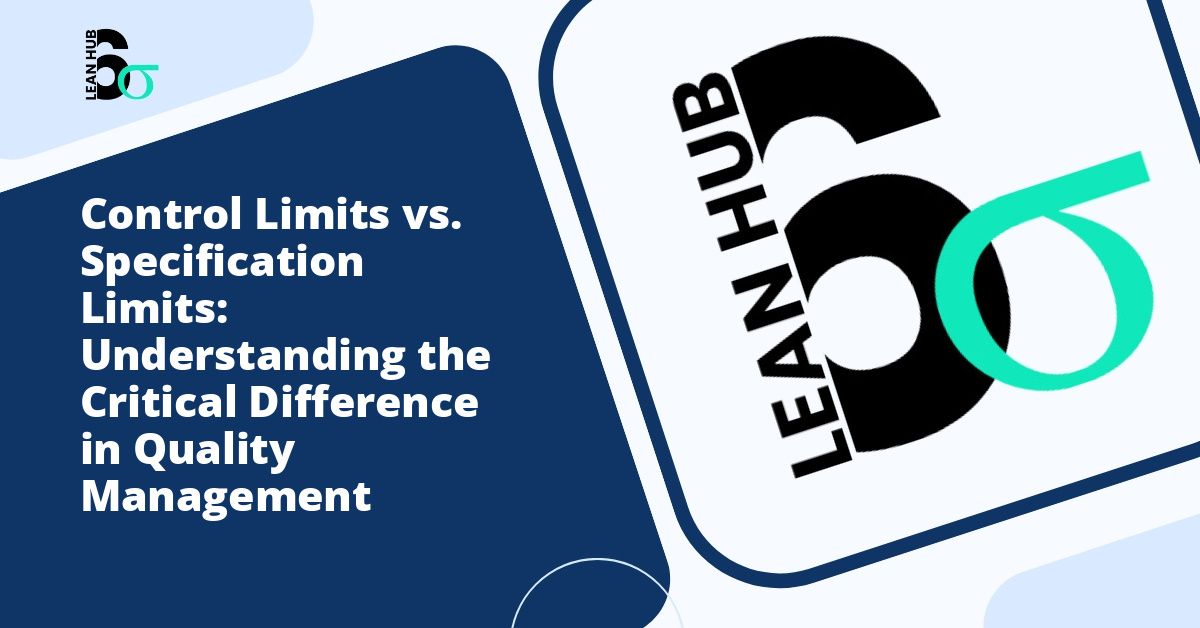In the world of quality management and process improvement, few concepts are as fundamental yet frequently confused as control limits and specification limits. While both serve crucial roles in monitoring and maintaining quality standards, understanding their distinct purposes is essential for anyone involved in manufacturing, service delivery, or continuous improvement initiatives. This comprehensive guide will clarify these critical differences and explain how each contributes to organizational excellence.
What Are Specification Limits?
Specification limits represent the voice of the customer. These are predetermined boundaries that define what is acceptable or unacceptable for a product or service characteristic. Specification limits answer the fundamental question: “What does the customer need or expect?” You might also enjoy reading about Control Charts in Six Sigma: Choosing the Right Chart for Your Data Type.
These limits are typically established through customer requirements, engineering standards, regulatory mandates, or contractual agreements. They exist independently of the actual process performance and reflect external expectations rather than internal capabilities. You might also enjoy reading about Statistical Process Control Explained: Monitoring Your Process Over Time.
Types of Specification Limits
Specification limits generally fall into three categories: You might also enjoy reading about How to Read and Interpret Control Charts Without Getting Confused: A Comprehensive Guide.
- Upper Specification Limit (USL): The maximum acceptable value for a quality characteristic
- Lower Specification Limit (LSL): The minimum acceptable value for a quality characteristic
- Target Value: The ideal or nominal value that the process should aim to achieve
For example, if a pharmaceutical company manufactures tablets, the specification might require each tablet to weigh between 495mg (LSL) and 505mg (USL), with a target of 500mg. Any tablet falling outside this range would be considered defective, regardless of whether the manufacturing process is stable or unstable.
What Are Control Limits?
Control limits represent the voice of the process. These limits are calculated from actual process data and indicate the natural variation inherent in a stable process. Control limits help answer the question: “What is our process actually capable of doing?”
Unlike specification limits, which are fixed by external requirements, control limits are dynamic and reflect the current state of process performance. They are typically calculated using statistical methods and are displayed on control charts, a fundamental tool in statistical process control (SPC).
Understanding Control Chart Limits
Control limits are calculated using historical process data and typically set at three standard deviations (3σ) from the process mean. This statistical approach provides:
- Upper Control Limit (UCL): The upper boundary of expected process variation
- Lower Control Limit (LCL): The lower boundary of expected process variation
- Center Line: The process average or mean
When data points fall within the control limits and exhibit random variation, the process is considered “in control” or statistically stable. Points outside these limits signal special cause variation that requires investigation and corrective action.
The Critical Differences Between Control Limits and Specification Limits
Understanding the distinction between these two types of limits is crucial during the recognize phase of any quality improvement initiative. During this initial assessment period, practitioners must accurately identify whether problems stem from process instability, inadequate process capability, or both.
Origin and Purpose
Specification limits originate from customer needs, regulatory requirements, or design specifications. They define what should be produced. Control limits, conversely, originate from the process itself and describe what the process is currently producing under normal operating conditions.
Calculation Methodology
Specification limits are determined through customer requirements analysis, engineering calculations, or industry standards. They remain constant unless customer needs or regulations change. Control limits are calculated using statistical formulas based on actual process measurements and will change whenever the process itself changes fundamentally.
Relationship to Quality
A product can meet specification limits but still come from an out-of-control process, meaning future products may not meet specifications. Conversely, a process can be in statistical control but consistently produce items outside specification limits, indicating the process is not capable of meeting customer requirements.
The Role in Lean Six Sigma Methodology
Within lean six sigma frameworks, both control limits and specification limits play vital but distinct roles. Lean six sigma practitioners must understand these differences to effectively improve processes and reduce variation.
During the recognize phase of problem-solving, teams must identify whether issues arise from special cause variation (indicated by points outside control limits) or common cause variation (inherent process variation within control limits). This recognition guides the selection of appropriate improvement strategies.
Process Capability Analysis
The relationship between control limits and specification limits reveals process capability. Several scenarios may exist:
- Capable and Controlled: Control limits fall well within specification limits, and the process is stable
- Incapable but Controlled: The process is stable, but control limits exceed specification limits
- Capable but Uncontrolled: Specification limits are wider than potential control limits, but the process exhibits instability
- Incapable and Uncontrolled: The process is both unstable and unable to meet specifications
Lean six sigma tools such as Cpk and Ppk indices quantify these relationships, providing objective measures of process capability relative to customer specifications.
Common Misconceptions and Mistakes
Many organizations make critical errors by confusing these two concepts. Understanding these common mistakes can help you avoid them in your quality management efforts.
Plotting Specification Limits on Control Charts
While some practitioners plot specification limits on control charts for reference, this practice can lead to confusion. Control charts are designed to monitor process stability, not conformance to specifications. Mixing these concepts may cause teams to react inappropriately to normal process variation or ignore signals of process instability.
Assuming In-Control Means Meeting Specifications
A process operating within control limits is not necessarily producing acceptable products. If the process average is off-target or process variation is too large, an in-control process may still generate defects. Process control and process capability are separate concepts requiring different management approaches.
Setting Control Limits Equal to Specification Limits
Some organizations mistakenly set control limits equal to specification limits, hoping to catch defects before they occur. This approach misunderstands the purpose of control charts and will result in frequent false alarms, as natural process variation will regularly approach specification boundaries.
Practical Applications in Quality Management
Understanding the difference between control limits and specification limits enables more effective quality management strategies.
When to Use Specification Limits
Use specification limits when evaluating product or service conformance, calculating defect rates, determining customer satisfaction levels, or making accept or reject decisions for individual items.
When to Use Control Limits
Use control limits when monitoring process stability over time, distinguishing between common cause and special cause variation, determining when to investigate process changes, or assessing the need for process improvements.
Implementing Effective Quality Control Systems
Successful quality management requires both types of limits working together. Organizations should establish clear specification limits based on customer requirements, then implement control charts to monitor process stability. Regular process capability studies should compare control limits to specification limits, revealing opportunities for improvement.
During the recognize phase of problem-solving initiatives, teams should collect baseline data to establish both what customers need (specifications) and what the process delivers (control limits). This dual perspective provides a complete picture of current performance and improvement opportunities.
Conclusion
Control limits and specification limits serve complementary but distinct purposes in quality management. Specification limits define customer requirements and acceptability boundaries, while control limits describe actual process behavior and stability. Confusing these concepts leads to ineffective quality control, inappropriate reactions to variation, and missed improvement opportunities.
By clearly understanding these differences, quality professionals can implement more effective monitoring systems, make better decisions about process interventions, and ultimately deliver products and services that consistently meet customer expectations. Whether you are implementing lean six sigma methodologies or simply seeking to improve your quality management practices, mastering this fundamental distinction is essential for success.
Organizations that properly apply both control limits and specification limits create robust quality systems that not only detect problems quickly but also prevent them from occurring in the first place. This dual approach represents the foundation of sustainable quality excellence and continuous improvement.








